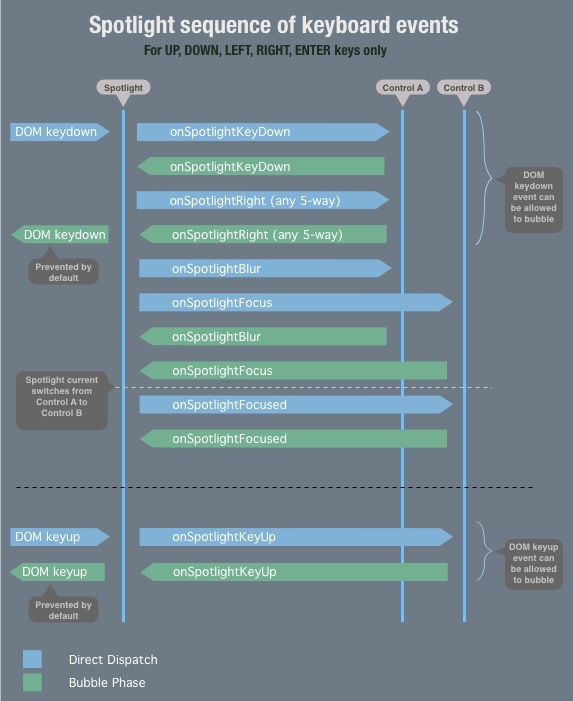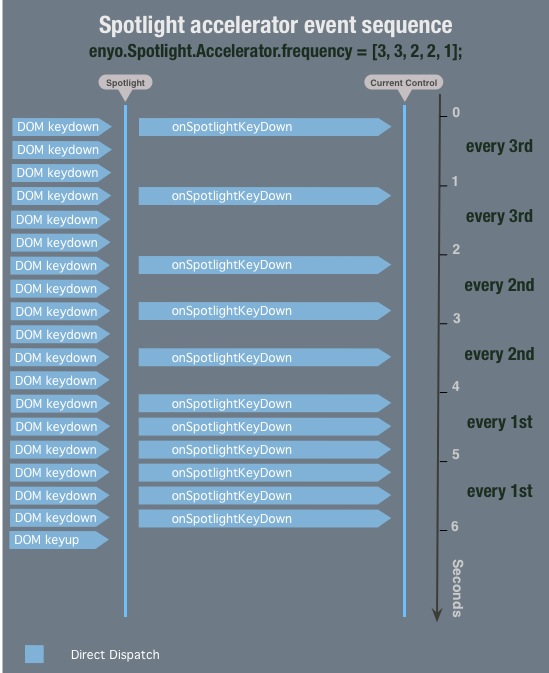Spotlight
- What Is Spotlight?
- Modes
- Navigation
- Containers
- Nesting
- Events
- Extending Spotlight
- Control Parameters
What Is Spotlight?
Spotlight is an extensible utility that enables users to navigate Enyo applications using a keyboard or television remote control. Responding to input from the UP, DOWN, LEFT, RIGHT, and RETURN keys, Spotlight provides a navigation experience that compares favorably to that of a computer-with-mouse.
In addition, Spotlight includes support for point-and-click events, so all bases are covered.
To add Spotlight to an application, simply require spotlight in one of your source files:
var Spotlight = require('spotlight');Modes
Spotlight operates in two mutually exclusive modes: 5-way mode and Pointer mode. By default, Spotlight is configured to switch between these modes whenever suitable input is received--i.e., it switches to pointer mode on mousemove and back to 5-way mode on keydown.
The Spotlight API also provides a way to make the switch explicitly:
Spotlight.setPointerMode(<Boolean>);Navigation
Spotlight enables navigation between Enyo controls by assigning focus to one control at a time. When a control is focused, it takes on the CSS class .spotlight, which allows focused controls to be styled on a per-kind basis using .<kindClass>.spotlight selectors.
In order to make a control focusable (or "spottable") with Spotlight, simply set its spotlight property to true, like so:
{name: 'mybutton', tag: 'button', spotlight: true}When the application loads, Spotlight searches for a control with the name specified in its defaultControl property; if defaultControl is not specified, Spotlight assigns focus to the first available spottable control.
In 5-way mode, Spotlight uses the Nearest Neighbor Algorithm to determine which spottable control is the nearest one in the direction of navigation. The coordinates of a spottable control are derived from its actual position on the screen.
It's worth noting that spottable controls may be found on different hierarchical levels of an Enyo component tree. Spotlight facilitates seamless navigation among the topmost spottable components found in the tree.
For a demonstration of the Nearest Neighbor algorithm's behavior, see "ContainerSample" in the Enyo sampler.
Containers
In order to organize controls into navigation groups, we have created Spotlight containers.
A good example of how containers should be used is a set of radio buttons that must be navigable separately from the rest of the app's controls.
When a Spotlight container is focused, it passes the focus to its own hierarchy of spottable child controls--specifically, to the last spottable child to hold focus before the focus moved outside of the container. If the container in question has never been focused, it passes focus to its first spottable child.
To define a container, set a control's spotlight property to "container":
{
name: 'mycontainer',
spotlight: 'container',
components: [<A list of controls with `spotlight:true`>]
}In a way, containers may be thought of as the branches--and spottable controls as the leaves--of the Spotlight navigation tree.
For a demonstration of container behavior, see "ContainerSample" in the Enyo sampler.
Nesting
Spotlight containers may be nested. The inner containers may be remembered as "last focused children" of the outer ones, thus acting as conduits of focus passed by the outer containers.
We have not found it useful to nest spottable controls. For now, these controls act as the leaves of the spottable tree and do not conduct focus; however, this behavior may be overridden on a per-control basis.
Events
All Spotlight events are dispatched directly to the currently spotted control, which may prevent bubbling to define custom behavior. (See Extending Spotlight below.)
If Spotlight events are allowed to bubble to the application level, the app responds to them with default behavior.
List of Spotlight Events
The following events are dispatched by the main Spotlight module:
onSpotlightKeyDown: Dispatched in response tokeydownonSpotlightKeyUp: Dispatched in response tokeyuponSpotlightLeft: Dispatched in response toonSpotlightKeyDownevent's bubbling to app level with keyCode 37onSpotlightRight: Dispatched in response toonSpotlightKeyDownevent's bubbling to app level with keyCode 39onSpotlightUp: Dispatched in response toonSpotlightKeyDownevent's bubbling to app level with keyCode 38onSpotlightDown: Dispatched in response toonSpotlightKeyDownevent's bubbling to app level with keyCode 40onSpotlightSelect: Dispatched in response toonSpotlightKeyDownevent's bubbling to app level with keyCode 13onSpotlightFocus: Dispatched when focus is transferred to a new control in response to one of the 5-way events (onSpotlightLeft,onSpotlightRight,onSpotlightUp,onSpotlightDown, oronSpotlightSelect).onSpotlightBlur: Dispatched when focus is transferred away from a controlonSpotlightFocused: Dispatched in response toonSpotlightFocusevent's bubbling to app level right after its originator is set as currentonSpotlightScrollUp: Dispatched whenmousewheelevent delta exceedsSpotlight.Scrolling.frequency(Default: 40)onSpotlightScrollDown: Dispatched whenmousewheelnegative event delta exceeds-Spotlight.Scrolling.frequency(Default: 40)
Preventing or Allowing Default DOM Events
By default, if a keydown event carries a 5-way keyCode (13, 37, 38, 39 or 40), it will be prevented from bubbling and triggering default browser behavior. This is done to disable default browser scrolling, because in the presence of Spotlight, scrolling is handled using components such as Scroller.
Of course, there are some cases where you may want to allow the default browser behavior. For example, in text inputs, you may want to allow the cursor to move to the next character when the right arrow key is pressed, without any interference from JavaScript.
For such cases, we have included an "Allow DOM Default" feature. The events onSpotlightKeyDown, onSpotlightLeft, onSpotlightRight, onSpotlightUp, onSpotlightDown and onSpotlightSelect pass their handlers an event object with an added allowDomDefault() method:
onSpotlightKeyDown: function (sender, ev) {
ev.allowDomDefault();
}In the above handler, if the Spotlight event is allowed to propagate, it will allow the original DOM keydown to trigger default browser behavior. (See Figure A).
Sequence of Spotlight Events

Figure A: Spotlight keyboard events
Figure A illustrates the sequence of events in Spotlight's 5-way mode. At each step, the sequence may be modified (bubbling may be prevented) on the level of the currently focused control. (See Extending Spotlight below.)
For instance, when onSpotlightKeyDown is dispatched to the focused control, the control may choose to prevent it from ever reaching the app level (where it would be handled by Spotlight) and replace the default behavior with its own custom handling.
If, however, onSpotlightKeydown is allowed to propagate and Spotlight recognizes its keyCode as one of 5-way key codes, it dispatches an onSpotlight<5-Way Direction> event back to the focused control. At this point, the control once again has the option of overriding default behavior.
If the onSpotlight<5-Way Direction> event bubbles up to the app level, Spotlight employs its Nearest Neighbor Algorithm to figure out which spottable control is closest in the <5-Way Direction>. It then dispatches an onSpotlightBlur event to the current control (which also has the .spotlight CSS class removed) and an onSpotlightFocus event to the nearest neighbor (which has the .spotlight CSS class applied).
If onSpotlightFocus is allowed to bubble from the newly focused control, Spotlight sets its originator as current, and it officially becomes the focused control. In recognition of this fact, Spotlight dispatches an onSpotlightFocused event to the control.
Accelerated keydown Events

Figure B: Accelerated keydown sequence
While a key is depressed, the browser dispatches keydown events at equal (or nearly equal) intervals.
Looking at Figure B, we can see that not all of these events affect the application. The function of the Spotlight Accelerator is to distribute events over time (according to its configuration).
Spotlight Accelerator may be configured via its array property, Spotlight.Accelerator.frequency. The default configuration is as follows:
//* Firing configuration. At n-th second use every frequency[n] subsequent keydown event
frequency : [3, 3, 3, 2, 2, 2, 1], ...This tells the Accelerator to do the following:
In the first, second, and third seconds after the key is depressed, only let through every third
keydownevent.In the fourth, fifth, and sixth seconds, allow every second
keydownevent.In the seventh second and later, allow every
keydownevent.
This causes Spotlight focus to move across the screen with apparent acceleration while a 5-way key is depressed.
Scroll Events
In response to mousewheel events from the browser, Spotlight dispatches onSpotlightScrollUp and onSpotlightScrollDown. Here's how the process works:
The mousewheel event has a wheelDeltaY property, which translates to a given amount of wheel rotation. Spotlight Scrolling accumulates wheelDeltaY values in a given direction of rotation (up or down).
Once the cumulative value exceeds Spotlight.Scrolling.frequency, either onSpotlightScrollUp or onSpotlightScrollDown is dispatched and the cumulative value is reset to 0.
In this way, Spotlight scrolling events are made to behave more like repeating keydown events, which is useful for controls (like pickers and list scrollers) that don't use smooth scrolling, but instead animate from one item to the next.
Note: In Pointer Mode, Spotlight treats the first scroll event as the first keyboard event; in response, Spotlight returns from pointer mode and re-spots the item that was previously spotted. No scrolling happens on the first scroll event when returning from pointer mode.
Customizing Response to 5-way Events
There may be times when the Nearest Neighbor algorithm does not meet your needs. For example, UI specs for an app may require you to specify where Spotlight focus should move in response to specific 5-way events.
For such cases, Spotlight offers a set of convenience properties:
defaultSpotlightUpdefaultSpotlightDowndefaultSpotlightLeftdefaultSpotlightRightdefaultSpotlightSelect
Simply add the appropriate property to your control, and if the corresponding event is allowed to bubble, Spotlight will move focus to the control whose name is specified in the property's value:
{name: 'control1', spotlight: true, defaultSpotlightRight: 'control2'},
{name: 'control2', spotlight: true, defaultSpotlightRight: 'control1'}In this example, focus will pass from one control to the other each time the right arrow button is pressed.
Extending Spotlight
Extending Controls
Extending an Enyo control to use Spotlight functionality does not require knowledge of anything beyond Enyo's inheritance patterns and the information presented in this document.
To extend a control to use Spotlight, simply create a subkind of the kind you want to extend and define event handlers to handle Spotlight events.
Please refer to the Moonstone package for examples.
Control Parameters
Two optional properties may be set on controls to change the way that Spotlight interacts with them:
spotlightDisabled [boolean] - When set to
true, temporarily makes a component non-spottable without changing itsspotlightproperty.spotlightIgnoredKeys [number | array] - Specifies a set of keys to be ignored by Spotlight when they originate from the component.
